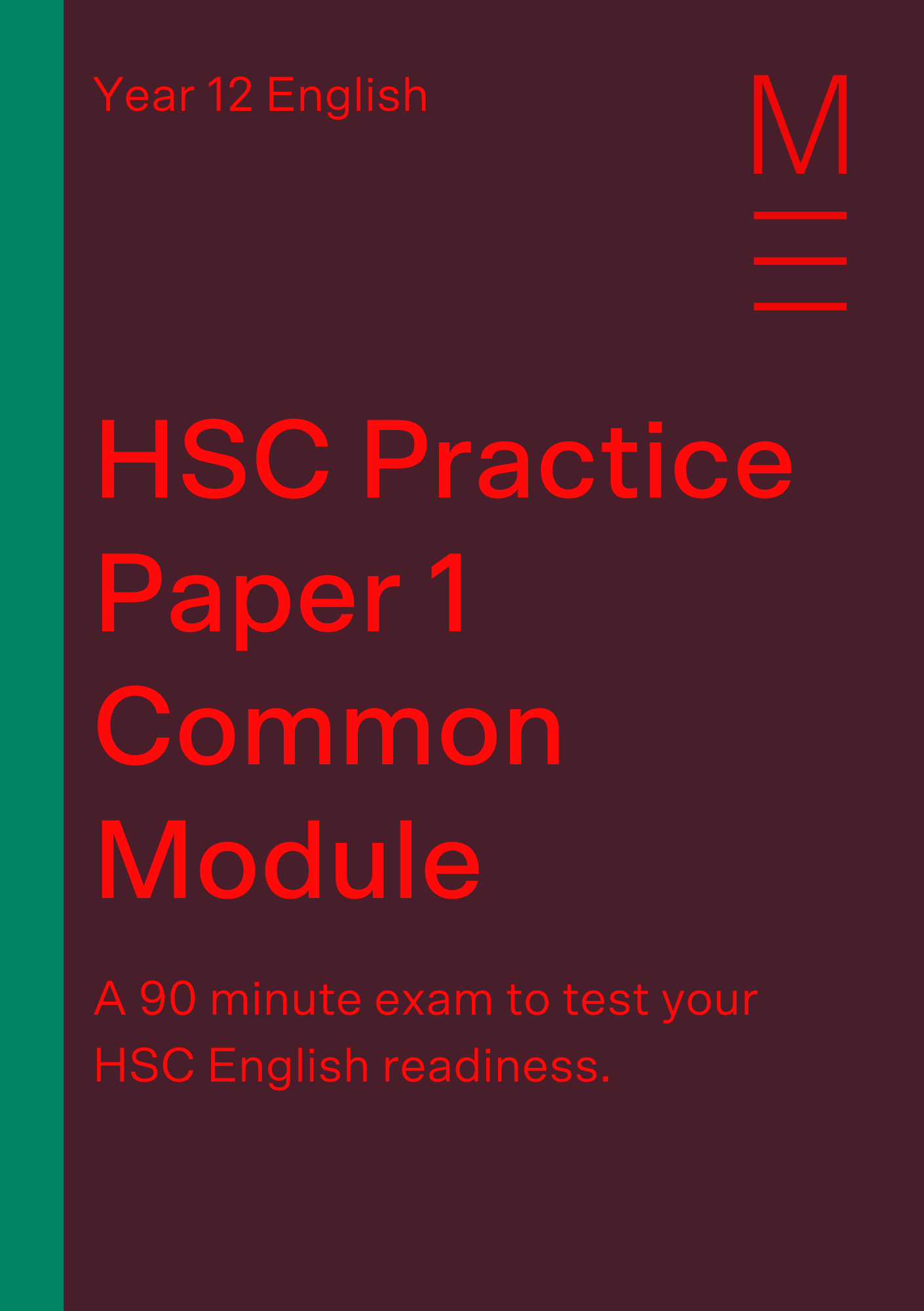

Unseen texts: a guide
Elyse Popplewell
Thursday 27th, July 2017
Paper one, section one: the unseen texts.
The first section of the exam paper is designed for you to read and analyse the texts presented and then respond to them through the lens of a series of questions. This section is worth 15 marks, as is Section Two and Section Three respectively.
How to do the unseen texts
I truly believe it is best practice to read the question corresponding to the text you are reading, as well as the last question of Section One which usually asks you to choose which texts you will use to answer with, unlike the precedingf questions which will specifically quiz you on a particular text. The reason for looking to this last question is because you should be able to have it sitting in the back of your mind as you look for which text is the best candidate. The reason for reading the question corresponding to the text before beginning your initial reading is simply so that you can actively seek the answers in the text as you read it.
In your first reading…
You need to understand the essence of the plot in order to analyse the way the events of discovery have unfolded. You’ll also need to be actively looking for sections of the text to use as analysis in your responses.
What techniques do I look for?
Obviously there are techniques unique to a medium and I’m sure you know some of them. For example, vector lines in visual images and rhyming schemes in poems. When approaching the text for the first time, be aware of the techniques that are commonly used in that particular text type. There will also be a whole bunch of techniques that move across mediums – similes, metaphors, imagery, personification…
I want to point out some things you mightn’t consider talking about at first, but might prove very handy for you. Don’t forget to talk about the aspects of the text that aren’t the typical “techniques” we learn from junior school, but also talk about the general construction of the writing. If the title of the text is, “The letter” then it might be useful to talk about “the” being a definite article as opposed to an indefinite article (a/an). And don’t forget to look over simple things like the narrator: is it first person? Second person? Third person? Sometimes words are very powerful in a text even if they don’t rhyme, aren’t alliterative, and don’t really have that many spectacular features: but it’s important anyway. Usually this is because of connotations – such a simple thing to talk about! Don’t over complicate your analysis, sometimes sentence length, the connotations of adjectives, and the modality, are all you need to answer a question!
So here are some things you might talk about in literary texts. Use this list as a memory-jogger. It’s not all-inclusive, but it raises a few great leap pads.
Rhyming pattern or lack of
Punctuation – is it used?
Definite or indefinite articles
Active voice or passive voice
Narration point of view
Imagery (it doesn’t hurt to remember this can be divided: olfactory, aural…)
Alliteration
Personification
Sentence length/variation
Appropriation
But the visual texts?
In 2016, the HSC paper didn’t have a visual text in there. This broke the trend of a very long lineage of Sections Ones with visuals! Standard English students study a visual text as part of their prescribed texts, but it’s not always the case for Advanced English students to study a still-visual. The only reason it’s worth noting is that if you are an Advanced English student who hasn’t studied a still-visual since Year 10, then it’s time to refamiliarise yourself with some visual techniques! You might talk about:
Vector lines
Facial expressions
Captions/text
Background/foreground/midground
Bold/thin lines
Artistic style
Remember to keep an eye on the clock…
If you’re using the reading time for the unseen texts, you’ll potentially need to use a few minutes of the “writing time” to finish reading, depending on the texts you’re presented with. Then, if you’re going in to Section One with steam coming from your pen, it’s easy to get carried away. You might have practiced essays and creatives over and over again, so you would have a pretty good idea of the length of each and how long it will take you. The unseen texts don’t have that kind of predictability about them, so you need to be acutely aware of the clock.
And an eye on the mark allocation…
Don’t overwrite! If a question is worth three marks, plan exactly how you will achieve those marks sentence by sentence instead of “I’ll just vomit ink onto the page and hope for the best” because that, dear students, is where things get carried away and then you suddenly realise you’ve only got an hour to go and you’ve not touched Section Two or Three yet. Being disciplined with your approach to how you answer the unseen texts is crucial to allocating your time well.
We created a practice Paper One for you to study with! Check it out here!
Featured Articles

Your Common Study Questions Answered!
Need some advice on how to study? Confused on the best ways to approach certain topics? Here are your common study questions answered. Is it better to handwrite or type notes? B...

What does it actually mean to “study smart”?
When I was in high school, I was often told to “study smart, not hard”. It’s a common high school trope and, to be completely frank, I didn’t know what it m...

The benefit of asking questions in high school
For whatever reason, asking questions through class can actually be pretty tough. Maybe you feel embarrassed about not knowing the answer. Maybe you haven’t yet developed rap...

How to study in high school - the 'dos' and 'don'ts'
As we know, different students study in different ways, and that’s totally fine. This article isn’t prescriptive - we’re not telling you what must be done - but w...

Sponsored by the Victorian Government - Department of Education
Looking for a career where you can make a difference?
With scholarships, incentives, supports and more, there's never been a better time to become a teacher.
Select a year to see courses
Learn online or on-campus during the term or school holidays
- Maths Acceleration
- English Advanced
- Maths Standard
- Maths Advanced
- Maths Extension 1
- English Standard
- Maths Extension 2
Get HSC exam ready in just a week
- UCAT Exam Preparation
Select a year to see available courses
- English Units 1/2
- Maths Methods Units 1/2
- Biology Units 1/2
- Chemistry Units 1/2
- Physics Units 1/2
- English Units 3/4
- Maths Methods Units 3/4
- Biology Unit 3/4
- Chemistry Unit 3/4
- Physics Unit 3/4
- UCAT Preparation Course
- Matrix Learning Methods
- Matrix Term Courses
- Matrix Holiday Courses
- Matrix+ Online Courses
- Campus overview
- Castle Hill
- Strathfield
- Sydney City
- Year 3 NAPLAN Guide
- OC Test Guide
- Selective Schools Guide
- NSW Primary School Rankings
- NSW High School Rankings
- NSW High Schools Guide
- ATAR & Scaling Guide
- HSC Study Planning Kit
- Student Success Secrets
- Reading List
- Year 6 English
- Year 7 & 8 English
- Year 9 English
- Year 10 English
- Year 11 English Standard
- Year 11 English Advanced
Year 12 English Standard
Year 12 english advanced.
- HSC English Skills
- How To Write An Essay
- How to Analyse Poetry
- English Techniques Toolkit
- Year 7 Maths
- Year 8 Maths
- Year 9 Maths
- Year 10 Maths
- Year 11 Maths Advanced
- Year 11 Maths Extension 1
Year 12 Maths Standard 2
Year 12 maths advanced, year 12 maths extension 1, year 12 maths extension 2.
Science guides to help you get ahead
- Year 11 Biology
- Year 11 Chemistry
- Year 11 Physics
- Year 12 Biology
- Year 12 Chemistry
- Year 12 Physics
- Physics Practical Skills
- Periodic Table
- VIC School Rankings
- VCE English Study Guide
- Set Location
- 1300 008 008
- 1300 634 117
Welcome to Matrix Education
To ensure we are showing you the most relevant content, please select your location below.
Ultimate Guide for How to Answer Common Module Unseen Questions
In this post, we give you the ultimate breakdown for acing the Common Module unseen questions for Texts and Human Experiences.
Get free study tips and resources delivered to your inbox.
Join 75,893 students who already have a head start.
" * " indicates required fields
You might also like
- 8 Common Mistakes HSC English Students Make in Exams
- Ashish’s Hacks: How I Scored An ATAR of 98
- 2023 HSC Maths Ext 1 Exam Paper Solutions
- Glenn’s Hacks: Balancing The HSC, UCAT, And A Social Life To Achieve A 99.10 ATAR
- University Bonus Points
Related courses
Do you struggle with unseen texts?
Do you always run out of time in for comprehension questions?
Do you know what your responses are meant to look like?
In this post, we will show you how to prepare for and ace the HSC Common Module Paper 1 Short Response Questions.
What skills do I need to ace the Paper 1 unseen questions?
Section 1 of Paper 1 tests a few different things:
- Comprehension skills
- Textual analysis skills
- Knowledge of the Common Module: Texts and Human Experiences
- Ability to write clear and concise responses
Want to put your skills to the test?
You can download the paper with unseen texts and then we’ll send you sample responses along with marking criteria 24 hours later.

Download your practice English HSC Paper 1
Test your English skills and knowledge with our free exam
Done! Your download has been emailed.
Please allow a few minutes for it to land in your inbox.
We take your privacy seriously. T&Cs and Privacy Policy .

Comprehension Skills
You need to be able to quickly read questions and unseen texts to construct responses
You need to be able to quickly analyse unseen texts. It is not enough to be able to spot superficial techniques in a text. Matrix students learn how to analyse unseen texts for higher order techniques and understand how these are developing the themes and ideas in the texts.
To succeed in Paper 1, you need to be able to do a quick analysis and then connect this analysis to the concerns and ideas that you have studied in the Common Module.
If you need help getting on top of your textual analysis skills, you should read our Beginner’s Guide to Acing HSC English Part 1: How to Analyse Your English Texts for Evidence .
Knowledge of the Common Module: Texts and Human Experiences rubric
If you want to write insightful responses to the Paper 1 unseen questions, then you need to have a detailed knowledge and understanding of the Common Module: Texts and Human Experiences rubric.
If you are unsure of what the Module is about or want to get a detailed understanding of it, then you must read our Year 12 English Advanced Study Guide article .
Students are often unsure of what they need to do when writing a response to unseen sections. How much do you need to write? How little?
When answering short answer questions, clarity and concision are key.
In fact, more important than the length is the quality and concision of the writing. Matrix students learn how to produce erudite and insightful responses that clearly relate their ideas and answers to the questions with supporting evidence.
What’s the structure of the Common Module HSC Paper 1?
Let’s look at the structure of Paper 1:
English Advanced Paper 1 has two sections:
- short response questions
- long response or essay section
The short response questions will involve 3-4 unseen texts and a series of 4 or 5 questions. This section will be worth 20 marks.
You will have 10 minutes reading time and 45 minutes writing time to complete each section.
How long are the texts that I have to read for the unseen section?
That will depend.
In previous HSC Paper 1 exams, the length of the unseen texts has varied significantly. In some years, students have had no trouble reading all of the unseen texts, but in others, such as the 2018 HSC, students have struggled to complete the reading in the allocated time.
In the sample 2019 Paper 1 provided by NESA , for example, there are a pair of posters, a 30 line poem, a 536-word non-fiction piece, a 983-word non-fiction piece, and a longer extract from a fiction text.
The length of the unseen texts is a significant challenge that you must account for in your preparation and exam strategy. We’ll discuss the strategies Matrix students use later in this post.
These questions will total 20 marks, one question will require a miniature essay for a response. Students will need to allocate a little over 2 minutes per mark when responding to questions.

How do I study for the Common Module Paper 1 Exam?
As we discussed above, the skills you need are:
But how do you develop and hone these skills?
Practise and feedback!
English is not an innate skill.
Successful English skills are developed through a consistent reading, an ongoing study practice, and regular writing and feedback cycle.
If you want to be able to approach your next unseen paper with a swagger, you need to practice unseen sections before-hand and get feedback on your responses.
So, how do I practise analysing unseen texts?
You need to find short texts online and practice reading them and analysing against a timer.
A good process for doing this is to find texts that are similar in media, form, and length to previous HSC unseen texts and try to identify the main ideas and themes and a set number of examples within a few minutes.
This is actually quite a challenging task, especially the first few times that you try it.
To develop these skills try the following:
- Pick a text of the appropriate length and type
- Give yourself 10 minutes on a timer
- Set yourself a target of, say, 2 themes/ideas and 5 techniques to identify
- Analyse the text to the timer and underline notate the examples you find
- Check your answers
- Try it again on a similar timer, but with only 7.5 minutes on a timer
- Keep practising until you can comfortably analyse a text in 2-3 minutes.
How should I practise my short answer responses?
The skills you need to write a good short answer response are developed through practice and feedback.
Your peers who consistently get full marks for their unseen sections do so because they practise writing responses and get feedback on how to improve them and make them more concise and efficient. All conscientious English Advanced students should be scoring Band 6 for their unseen responses, if not full marks.
To practise your unseen responses, do the following:
- Get your hands on a practice paper. You can find past Area of Study: Discovery papers here on the NESA website or, even better, try your skills on our Matrix English Advanced Common Module Practice Paper 1 .
- Set yourself a timer for 65 minutes. Allow 15 minutes reading time and 50 minutes writing time.
- Attempt the paper.
- Mark your responses against the marking rubrics and exemplar responses provided or get feedback from your teacher or peers
- Find another practice paper and attempt that, working to a shorter time limit.
Want to ace English?
Book your free English Trial Lesson today. Join over 4500 students who already have a head start in English over their peers. Book your free trial lesson .

Structuring a short response answer
One of the most common questions that students have about short responses is how long their responses should be.
The length of your responses will vary depending on how many marks the question is worth and how much time you can allocate to it.
For example, a three mark question is only worth 7 minutes of your time. So, you’re only going to be able to produce about 100-200 words at most (people tend to average about 13-31 words per minute by hand) in that amount of time depending on your handwriting. You need to keep your writing legible, too. It’s no point bashing out an amazing 210-word response if nobody can read it. Your marks would be better off with something much shorter and more legible.
You want to aim for one example and explanation per mark on offer. For example, if you have a two mark question, provide two examples and analysis of those examples.
The extended short response question
The final question for the short response questions is usually worth between 6 and 7 marks and requires a miniature essay in response. The question can ask you to discuss one text or several. It is important that you structure your response accordingly.
This means you need a brief introduction , a body paragraph or two, and a brief conclusion .
Your introduction needs to briefly introduce your chosen text(s) and their relevance to the question. Try to include terms or phrases from the Common Module rubric in your thesis, as this will directly address the module concerns. You should keep your introduction under two sentences.
Your body needs to expand on these ideas. It is important that you use topic sentences to introduce your ideas.
If you must discuss two texts, you need to choose between writing a divided (a paragraph on each text) or integrated response (discussing both texts in one paragraph). Whichever structure you choose, you need to present two or three examples from each text and discuss them in detail.
If the question asks you to contrast or compare the texts, you must discuss the texts in relation to each other.
This will usually entail discussing how one text represents an aspect of human experience or emotion more effectively than another. Ensure that you relate your examples to the question, don’t just list technique, example, and effect.
Finally, your conclusion must summarise the argument, relating it back to the question and Common Module. Make sure that you restate your thesis. Aim for at least one sentence, if not two.

Answering a short response question
To get a sense of what you should include in a short response answer, let’s consider one of the NESA sample questions from their mock 2019 paper .
Example B (6 marks) English Standard and English Advanced Compare how Text 2 and Text 3 explore the paradoxes in the human experience.
Text 2 can be found here and Text 3 is in the NESA sample paper.
Analysing the texts
Before you can write your response, you need to analyse the texts. It is important to use the question to guide the focus of your analysis.
This question asks students to discuss the paradoxes in the human experience. This is a statement from the rubric. A paradox is a statement that seemingly contradicts itself. So our analysis of these texts needs to focus in on things that seem contradictory or logically unacceptable.
Analysing Text 2
Text 2, Vern Rustala’s “Looking in the Album,” is an ekphrastic poem. Ekphrasis is the representation of an image in prose or poetry. In this poem, the speaker describes several photographs and little aspects of each.
The poem explores how photographs can only capture a limited aspect of human experience, even though they trigger memories. The poem also discusses how photographs don’t capture all of the moments and are often carefully curated.
There are a couple of paradoxes present, here:
- Photographs capture moments of our lives and trigger authentic memories but are staged and falsified records
- Photographs don’t carry the records of our negative experiences of our lives. We often curate those out to give a “true account” of our lives.
Next, you need to find some examples that bear these paradoxes out. Because this is a 6 mark question and we have to compare two texts, we will look for two examples. One for each paradox. We will use the text’s form as our other example.
Analysing Text 3
In Text 3, Hillary McPhee explores the trouble she has in reconciling her profession as a historian with her love of her family’s stories and her grandmother’s ability to tell them.
This is an autobiographical text. It is a memoir that discusses her experience of mixing her personal and professional lives and the consequences of this.
This text discusses the conflict between wanting to know the truth about something and enjoying the romance of how it has been told.
There are a couple of paradoxes in this text as well:
- We can either know the truth about something or appreciate the romantic or mythic nature of it
- We can’t reconcile factual truths with family storytellers
Next, let’s look at some evidence. This time we’ll look at three examples, because this text’s paradoxes need a little more framing. McPhee opens with an extended metaphor that introduces the ideas:
Now we’ve got some evidence, we’re in a position to write a response.
Writing the response
Let’s look at the question again:
Example B (6 marks) English Standard and English Advanced “Compare how Text 2 and Text 3 explore the paradoxes in the human experience.”
So, this is a 6 mark question and requires us to compare the texts. This means that we need to use a miniature essay structure.
We then need to decide whether to use an integrated or divided response:
- An integrated response will allow us to be more efficient in our comparison.
- A divided response will be a little more straightforward for presenting our analysis but will require us to spend the second paragraph doing the comparison.
Your marks won’t be affected by your decision, only by the quality of your execution.
Our response will take the following structure:
Introduction : Two or three sentences outlining our response to the question and introducing the texts.
Body : An integrated response that analyses the texts and compares their representations of paradox in human experience across two paragraphs.
Conclusion : Two sentences that summarise your argument and connect it to the Module.
Okay, so what would this look like? Let’s look at the type of exemplary response a Matrix student would write.
Exemplar response
Both Hillary McPhee and Vern Rustala explore the paradoxes we find in our human experiences. Rustala’s poem, “Looking in the Album,” delves into the idiosyncrasies and paradoxes of how we curate and remember our lives. While McPhee’s biographical excerpt catalogues the paradoxes and ironies she wrestled with while trying to balance her professional self with her personal self.
Memory and the process of remembering are rich with emotional complexity and, yet, fraught with paradox. Rustala employs a free-verse poem with heavy enjambment to reflect the conflicts and paradoxes of how we catalogue and record our lives. The persona’s observation that “Here the formal times are surrendered / to the camera’s indifferent gaze” combines enjambment and personification to convey the paradox of how we remember our lives. While humans keep photographs to remember important occasions and feel nostalgia for them as it is an important part of our emotional experience, the speaker observes that we relinquish control over them to an external force – one that is insouciant about our experience or feelings. In contrast, McPhee’s biography focuses on her own experiences and evokes nostalgia in her extended metaphor that “her stories [came] like webs across the world… and her stories invaded our dreams.” As Rustala’s images are a contrived remembrance of the past, so are McPhee’s grandmother’s. Only, in contrast, McPhee ascribes these partially fictionalised accounts a positive value.
“Looking in the Album’s” speaker is troubled by how photographs alter our past and, potentially, our memories when they observe that “[w]e burned the negatives that we felt did not give a true / account and with others made this abridgement of our lives.” The pun on “negatives” conflates photographic images with the poor experiences, developing the metaphor that by destroying negatives we are trying to cleanse ourselves of negative experiences. We can find a paradox at the heart of the ironic notion of manipulating things we feel do not “give a true account” of our lives. Essentially, Rustala is suggesting that we wish to have a true record, but adulterate it to suit our feelings. McPhee struggles with a similar yet different reconciliation between the true and romanticised accounts of her Grandmother’s life. In each paragraph McPhee explores the historical facts and contrasts them to her Grandmother’s accounts, instilling doubt into the veracity of her accounts with the truncated statements “[o]r so she said.” and “[o]r so the story goes …” These caveats frame the paradox she faces: she can’t be a nostalgic granddaughter and a historian at the same time. Pursuing truth comes at the expense of nostalgia. She makes this clear when she ironically observes that “[t]he historian at the back of my brain says I should discover what is true and what is false” while “[t]he rest of me… still sees… the shapes and shadows of other places she made my own.” The contrast between these two sides of her life highlights the emotional paradoxes that can affect our lives as we try to balance professional success with emotional fulfilment and happiness, nostalgia and fact.
Human experience is emotionally complex as we try to hold onto our past while struggling with the acceptable shape it must take. The differences between McPhee’s and Ruslata’s texts highlight this struggle – pointing to how sometimes our emotional security requires us to see things as they actually happened while at others we must shroud events in myth.
Sitting the Exam
Now let’s look at some Dos and Don’ts for the unseen section of Paper 1.
Time Management
Planning your time for Paper 1 is essential. You have 1 hour 40 minutes to complete the section. That breaks down to 45 minutes per section and 10 minutes reading time.
Do read the questions first.
Then read them again. To be efficient and accurate you need to read the unseen texts with the questions in mind.
Don’t just read the texts, analyse them.
As you read look for evidence that will help you answer the questions. The questions usually ask you to address specific ideas in each text. This is done to guide you to the examples you need to collect.
Do use your maths skills to calculate how much time to allocate to answering each question.
Each mark is worth 2.25 minutes of your time. This means that for a 2 mark question you don’t want to spend more than 5 minutes answering it. By this rationale, you want to be spending about 15-16 minutes on a miniature essay worth seven marks. If you don’t finish the question in the allotted time, cut your losses and start the next one.
Don’t answer the questions in order.
Make sure you analyse the texts based on the question, so you gather evidence for all of them. But don’t begin on the lower mark questions. Get the questions worth more in the bag, first.
Do respond to the question worth the most marks, first.
Be strategic and guarantee yourself the most marks that you can. Starting with the 6 or 7 mark question guarantees you a share of those marks. If you do run out of time before finishing one or two questions from the section, it is better that those questions are only worth one or two marks rather than a third of the paper!
Analysing the Texts
Analysing texts on the fly is hard. You will need to practice this skill and ensure you are familiar with a wide range of literary and visual devices. If you need to brush up on them, we explain a comprehensive set of devices and techniques in our Essential Guide to English Techniques .
Don’t rush the reading of the unseen texts during the reading time.
Reading the questions will guide you as to how the text should be read and analysed. The questions will ask you to discuss how a composer represents a specific idea from the syllabus rubric. You want to identify that idea in the text, and note how they represent it.
Do try to identify multiple examples in each text.
Collecting as much evidence as possible on your first reading will make that easier. That way you have enough evidence to respond to several questions. You don’t have time to go back and do another reading.
Don’t get caught up in superficial analysis.
Techniques like alliteration and rhyme might have pleasing aesthetic qualities, but they are not as useful for representing concepts as metaphors or similes.
Do focus on higher order techniques.
Literary devices such as metaphor, motif, and irony over simple techniques such as alliteration. Your ability to spot higher order techniques will make analysing the texts far easier. Remember, you should practice on random short stories and poems you find on the internet.
Don’t ignore form and medium.
Your unseen texts will all have different forms. It is important that you take the time to think about how the composers’ choice of form influences meaning. Ask yourself, “what is the composer trying to achieve by utilising this form or medium?” You want to discuss this in your responses.
Answering the Questions
Do answer the questions clearly and concisely.
Ensure that you are answering the question asked. Before writing a response, reread the question to ensure that it will be a direct answer.
Don’t recount the text.
This will generally not constitute an answer to the question. Instead, respond as succinctly as possible to the question.
Do plan your responses according to their value.
As a rule, if the question is worth one mark, use at least one example and an explanation of its technique and effect. If the question is worth two marks, use at least two examples.
Don’t prioritise quantity over detail.
Remember, the markers are looking for detailed explanations of how an example represents an idea, not how many examples you can present. You need to respond to the ideas in the module. To do this effectively try to use terms and phrases from the Common Module rubric.
Written by Matrix English Team
© Matrix Education and www.matrix.edu.au, 2023. Unauthorised use and/or duplication of this material without express and written permission from this site’s author and/or owner is strictly prohibited. Excerpts and links may be used, provided that full and clear credit is given to Matrix Education and www.matrix.edu.au with appropriate and specific direction to the original content.
Matrix teachers are experts in HSC Year 12 English Standard tutoring. Gain skills and confidence. Learn with on-campus or online programs.
Learning methods available
Year 12 English Advanced tutoring at Matrix will help you gain strong reading and writing skills for the HSC.
Boost your Maths marks and confidence with structured courses online or on-campus.
Start improving your Maths marks and confidence with structured courses online or on-campus.
Start improving your Maths Ext 1 marks and confidence with structured courses online or on-campus.
Start improving your Maths Extension 2 marks and confidence with structured courses online or on-campus.
Related articles

7 Hot Tips to Improve Your Memory
Always wondered how Sherlock manages to remember everything? Well, here are the 7 best tips that will help you remember nearly everything like Sherlock!

Yvann’s Hacks: Surviving Year 12 | The Gamer’s Guide to the HSC
Do you wish you could find a walk-through guide for the HSC like you can for most games? Well, in this post Yvann gives you just that in his guest blog post "Surviving Year 12: The Gamer's Guide to the HSC."

Michelle’s Hacks: How I Scored An ATAR of 99.95
Read How Michelle Wu scored an ATAR of 99.95. Here are Michelle's Top Tips!

IMAGES
VIDEO
COMMENTS
The first section of your the HSC English Exam Paper 1 is essentially your ‘unseen texts’ section. The HSC English unseen texts section provides a selection of texts (the sample papers, provided b…
1. Go to class. It may seem obvious, but the first step to acing an essay exam, is to attend class. In doing so, you’ll not only be able to hear the instructor’s perspective on the …
Learn about AQA Unseen Poetry for your GCSE English Literature exam. This revision note includes a breakdown of how to approach, plan and write your essay.
Being disciplined with your approach to how you answer the unseen texts is crucial to allocating your time well. We created a practice Paper One for you to study with! Check it out here!
To effectively prepare for your unseen essay question in your HSC English assessment you want to: Be familiar with the types of questions they could throw at you – so you want to get good at pattern recognition; Be able to respond to …
Do unseen texts questions terrify you? We explain how to survive Common Module unseen questions, an exemplar response, and dos and don'ts.